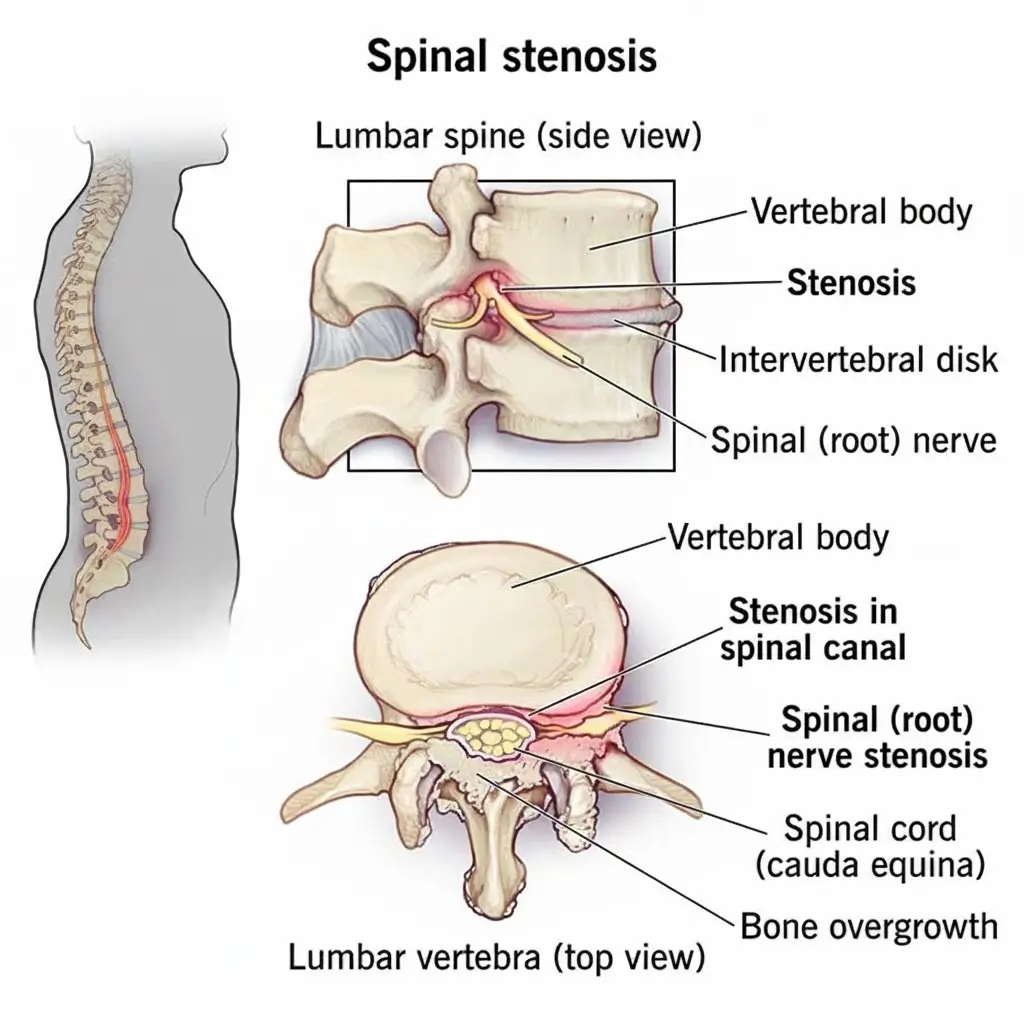- Home
- Spinal Stenosis
Spinal Stenosis
- Relief from Spinal Stenosis
Spinal Stenosis Treatment in Los Angeles, CA
If standing or walking for long periods makes your legs ache, tingle, or go numb but sitting brings relief you might be dealing with spinal stenosis. It’s a common condition that can quietly narrow your spinal canal and put pressure on the nerves that keep you moving.
At our Los Angeles spine center, Dr. Albert P. Wong helps patients find relief from spinal stenosis through careful diagnosis and minimally invasive treatments that reduce pain and restore mobility without unnecessary surgery.
- What It Is
What Is Spinal Stenosis?
Spinal stenosis is the gradual narrowing of the spaces within your spine. This narrowing can pinch the spinal cord or nerves, leading to pain, weakness, or numbness. It usually develops in the lower back (lumbar spine) or neck (cervical spine) and often progresses slowly over time.
You might hear it called spinal canal narrowing, nerve compression, or spinal cord impingement. Whatever the name, the end result is the same — pressure on nerves that can limit how comfortably you move, stand, or even rest.

Common Symptoms
Symptoms of spinal stenosis can vary depending on where the narrowing occurs. Common signs include:
- Back or neck pain that worsens when standing or walking.
- Tingling, burning, or numbness in the arms, hands, or legs.
- Weakness or heaviness in the legs.
- Cramping when walking long distances (called neurogenic claudication).
- Trouble with balance or coordination.
- In more advanced cases, bladder or bowel control problems.
Causes & Risk Factors
Spinal stenosis is most often caused by natural wear and tear that comes with age, but there are other contributing factors too. Common causes include:
- Arthritis leading to bone overgrowth or thickened ligaments.
- Herniated discs pressing on the spinal cord or nerves.
- Bone spurs (osteophytes) caused by degeneration.
- Spinal injuries or fractures.
- Congenital narrowing — some people are born with smaller spinal canals.
According to the Mayo Clinic and National Institute of Neurological Disorders and Stroke (NINDS), spinal stenosis most often affects adults over 50, though it can appear earlier in those with spine injuries or congenital spine conditions.
Diagnosis & Evaluation
Because spinal stenosis symptoms can overlap with other back problems, a detailed evaluation is key. Dr. Wong takes a thorough approach to diagnosis using state-of-the-art imaging and neurological assessments, such as:
- MRI scans, which reveal soft tissue and nerve compression.
- CT scans, for a clear view of the spine’s bone structure.
- X-rays, to detect bone spurs or vertebral misalignment.
- Nerve studies (EMG/NCS), to check for nerve damage.
Treatment Options
Not every case of spinal stenosis requires surgery. In fact, many patients find meaningful relief through conservative care tailored to their symptoms and lifestyle.
Non-Surgical Treatments:
- Physical therapy, to strengthen muscles and improve posture.
- Epidural steroid injections, which reduce inflammation around irritated nerves.
- Pain management programs to relieve chronic discomfort.
- Lifestyle modifications, like posture correction and low-impact exercise.
Surgical Treatments:
If conservative treatments don’t provide relief, surgery may be an option to open up the spinal canal and free compressed nerves. Dr. Wong specializes in:
- Minimally Invasive Decompression (Laminectomy or Laminotomy) — removes small portions of bone or ligament to relieve pressure.
- Spinal Fusion, to stabilize the spine when necessary.
- Artificial Disc Replacement, for select cases that benefit from preserving motion.
- Get Appointment
Schedule Your Consultation with Dr. Albert P. Wong
Schedule a consultation with Dr. Albert P. Wong in Los Angeles, CA and take the first step toward a more comfortable, confident future.
- Faqs
Frequently Asked Question
Learn more about spinal stenosis, its causes, symptoms, and treatment options. Dr. Albert Wong, MD, provides expert care in Los Angeles to help you find relief and regain mobility.
Symptoms may include back or neck pain, leg or arm numbness, weakness, difficulty walking, or tingling sensations that worsen with standing or walking.
Diagnosis involves a detailed medical history, physical examination, and imaging tests such as MRI, CT scans, or X-rays to identify the exact area of narrowing.
Surgery is typically recommended if conservative treatments fail and symptoms like pain, weakness, or numbness significantly affect your daily activities.
While spinal stenosis cannot always be reversed, effective treatments can significantly reduce pain, improve mobility, and enhance quality of life.
Yes, specific stretching and strengthening exercises can improve flexibility and reduce nerve pressure. Dr. Wong may recommend a personalized exercise plan.
